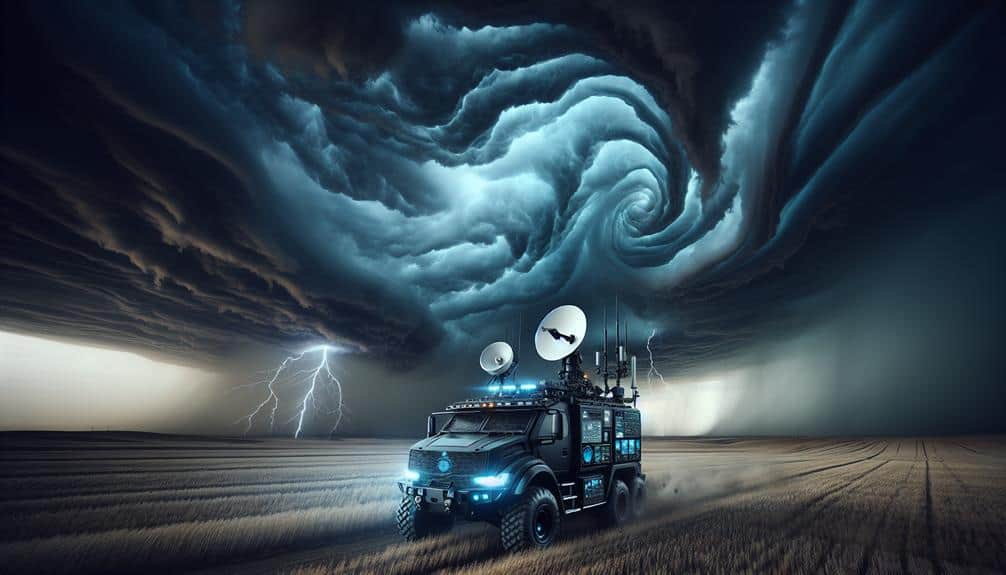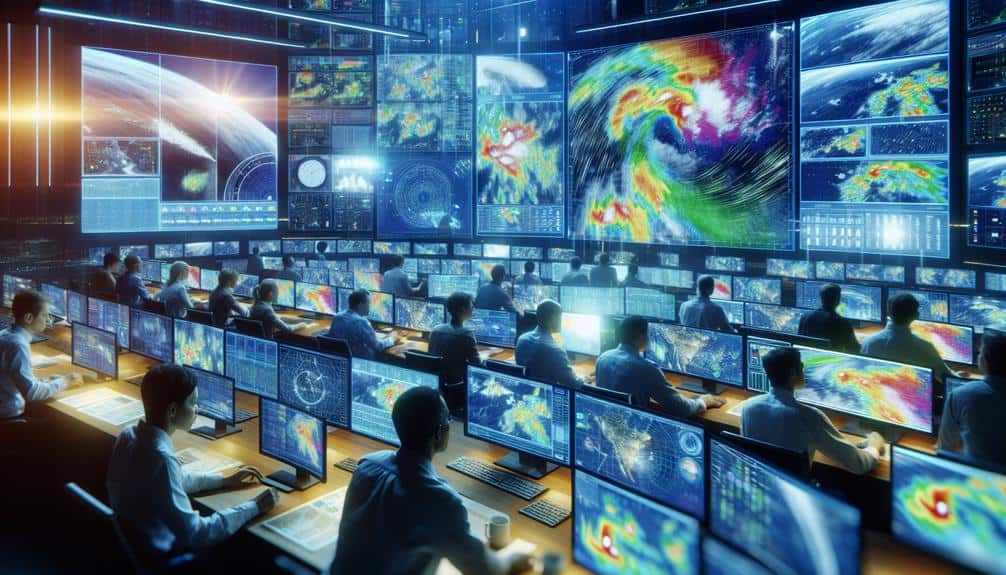Storm chaser strategies are critical for accurate predictions because we gather high-resolution, real-time data using Doppler radar, weather satellites, and automated weather stations. We then analyze meteorological patterns with advanced predictive modeling techniques, incorporating machine learning and historical data. Utilizing cutting-edge technology like dual-polarization radar and GOES-R satellites enhances our precision. Collaborative efforts with meteorologists and data analysts refine our models. This integrated approach improves public safety by fine-tuning early warning systems and optimizing evacuation plans. By understanding these strategies, we can better appreciate how they enhance prediction accuracy and benefit community preparedness.
Key Points
- Storm chasers provide real-time data on storm conditions, enhancing prediction accuracy.
- Advanced technology used by storm chasers refines predictive models through high-resolution observations.
- Collaboration with meteorologists and data analysts improves storm prediction strategies and reliability.
- Early warning systems benefit from storm chaser data, enhancing public safety and timely alerts.
Gathering Real-Time Data
To improve the precision of our storm predictions, we rely on advanced tools and technologies to gather real-time meteorological data. Our arsenal includes Doppler radar, weather satellites, and automated weather stations. These tools provide high-resolution, real-time observations that are vital for accurate forecasting. Doppler radar, for example, measures the velocity and intensity of precipitation, allowing us to detect rotation within thunderstorms—a key indicator of potential tornadoes.
Weather satellites offer a broader view, capturing data on cloud formation, atmospheric moisture, and temperature gradients. Automated weather stations, scattered across various geographic locations, feed continuous data on wind speed, barometric pressure, and humidity into our systems. This constant influx of real-time observations ensures data accuracy and timeliness, which are important for making informed predictions.
Our approach is highly analytical; we integrate data from multiple sources to create a detailed picture of current weather conditions. By cross-referencing these datasets, we enhance data accuracy and minimize errors. This multi-faceted strategy empowers us to make quick, reliable decisions, helping us stay one step ahead of the storm.
Ultimately, our commitment to real-time data collection supports our mission to provide accurate, timely forecasts, giving individuals the freedom to make informed choices about their safety.
Analyzing Meteorological Patterns
We'll start by examining weather data collection, focusing on the integration of radar and satellite imagery.
Next, we'll employ predictive modeling techniques, such as ensemble forecasting and machine learning algorithms, to enhance our accuracy.
Weather Data Collection
Analyzing meteorological patterns demands thorough examination of atmospheric data collected from advanced radar systems, weather satellites, and ground-based sensors. To guarantee accurate predictions, we employ a multifaceted approach incorporating drone surveillance and satellite imaging. These technologies allow us to capture high-resolution atmospheric data, providing crucial insights into storm dynamics.
Drones, with their ability to navigate hazardous weather conditions, collect localized data on temperature, humidity, and wind speed that traditional methods might miss. Aerial reconnaissance complements these efforts by offering a broader perspective on storm development, while ground observations provide essential real-time data points directly from the field.
By integrating data from these diverse sources, we can construct a comprehensive picture of current meteorological conditions. This synthesis allows us to identify patterns and anomalies that are crucial for predicting severe weather events. Our analytical approach doesn't stop at data collection; we meticulously cross-reference drone and satellite data with ground observations to validate our findings. This thorough verification process ensures that our data is reliable and actionable.
Ultimately, these strategies empower us to make informed decisions, providing a sense of freedom and security to communities in the storm's path.
Predictive Modeling Techniques
By leveraging advanced algorithms and machine learning, we can create predictive models that accurately forecast storm trajectories and intensities. Our primary goal is to harness vast datasets through statistical analysis to decode complex meteorological patterns.
Machine learning algorithms, particularly those utilizing neural networks and ensemble methods, allow us to analyze historical storm data, identify trends, and predict future storm paths with remarkable precision.
To achieve this, we feed our models real-time data collected from weather stations, satellites, and storm chasers. These datasets are then processed, cleaned, and normalized to guarantee the integrity of our inputs. By applying techniques like regression analysis and clustering, we can identify correlations and anomalies that traditional methods might miss.
Moreover, our models continuously learn and adapt. As new data flows in, machine learning algorithms refine their predictions, becoming increasingly accurate over time. This iterative process guarantees our forecasts remain dynamic and responsive to changing meteorological conditions.
Ultimately, our analytical approach empowers us with the freedom to understand and anticipate severe weather events better, enabling timely warnings and strategic responses. By integrating machine learning and statistical analysis, we push the boundaries of predictive meteorology, safeguarding lives and property.
Utilizing Advanced Technology

Integrating cutting-edge radar systems and satellite imagery significantly enhances our ability to predict storm patterns with greater precision. Technology innovations like Doppler radar and GOES-R satellites provide real-time data with remarkable accuracy. This high-resolution information allows us to track storms with greater detail, identifying potential severe weather events before they escalate.
By utilizing dual-polarization radar, we improve data accuracy by differentiating between types of precipitation, such as rain, hail, and snow. This level of detail is essential for forecasting precision, as it helps us understand the storm's structure and potential severity. Satellite-based sensors further augment our capabilities by capturing atmospheric conditions over vast areas, which ground-based systems can't reach.
Our analytical approach leverages machine learning algorithms to process this enormous volume of data, turning it into actionable insights. These algorithms learn from historical storm patterns, refining their predictions with each new data set. This continuous learning loop enhances our forecasting precision, enabling us to provide timely warnings and mitigate the impact of severe weather.
In essence, the integration of advanced technology not only boosts our data accuracy but also revolutionizes how we track storms, offering unprecedented freedom from the unpredictability of nature's fury.
Enhancing Prediction Models
We refine our prediction models by incorporating high-resolution climate data and complex atmospheric simulations, allowing us to anticipate storm behavior with remarkable accuracy. By leveraging detailed meteorological datasets, we enhance our data interpretation capabilities, making sense of intricate weather patterns. These datasets, sourced from satellites, radar, and ground-based sensors, provide granular information that feeds into our models.
Our approach hinges on algorithm optimization. By refining the algorithms that process this wealth of data, we can simulate storm development and progression with higher precision. This includes adjusting for variables such as wind speed, humidity levels, and temperature gradients, which are critical in predicting storm intensity and trajectory.
We utilize machine learning techniques to identify patterns and anomalies within the data. This analytical approach not only accelerates our processing time but also improves the reliability of our predictions. Machine learning algorithms can adapt and improve over time, making our models more dynamic and responsive to real-time data inputs.
Ultimately, our goal is to empower individuals with the freedom to make informed decisions based on accurate, up-to-date storm predictions. By continuously optimizing our models, we aim to provide the most reliable storm forecasts possible.
Collaborating With Experts

Leveraging expertise from meteorologists, climate scientists, and data analysts, we can refine our prediction models to enhance storm forecasting accuracy. Collaborating with these experts allows us to tap into a wealth of specialized knowledge and cutting-edge research.
Expert consultations provide us with insights that are essential for interpreting complex weather data. By forming research partnerships, we can access advanced tools and methodologies that individual storm chasers mightn't have.
Here are four key benefits we gain from these collaborations:
- Enhanced Data Accuracy: Experts provide validated datasets, ensuring our initial conditions are as precise as possible.
- Advanced Modeling Techniques: Collaborating with data analysts introduces us to sophisticated algorithms and machine learning models, which improve our predictive capabilities.
- Interdisciplinary Insights: Climate scientists offer perspectives on long-term patterns and anomalies, enriching our short-term storm forecasts.
- Real-time Updates: Meteorologists can supply up-to-the-minute information, allowing us to adjust our strategies on the fly.
Improving Public Safety
We can enhance public safety by refining our early warning systems with real-time data analytics and machine learning algorithms.
By supporting evacuation planning with precise, geospatial storm tracking, we enable faster, more accurate decision-making.
Our strategies will reduce response times and improve community resilience during severe weather events.
Early Warning Systems
Early alert systems, equipped with advanced meteorological instruments and real-time data analytics, enhance public safety by providing timely and accurate storm predictions. These systems leverage cutting-edge technology to ensure we're prepared for severe weather events.
By integrating data from storm chasers, satellites, and Doppler radar, we can create robust models that predict storm trajectories with remarkable precision. This capability allows for critical early alerts that can save lives and property.
Here's how early alert systems make a difference:
- Real-Time Data Integration: Combines inputs from various advanced technologies to offer a thorough view of weather patterns.
- Predictive Analytics: Uses historical data and machine learning algorithms to forecast storm development and potential impact zones.
- Communication Networks: Ensures rapid dissemination of alerts through multiple channels, including social media, to reach a broad audience.
- Evacuation Planning: Provides essential information that aids authorities in making informed decisions about evacuation routes and timing.
Evacuation Planning Support
By utilizing the real-time information and predictive analytics from early warning systems, we can greatly enhance the accuracy and timeliness of evacuation planning, thereby improving public safety. Storm chaser strategies provide invaluable insights into storm paths and intensities, allowing us to optimize evacuation routes and identify the most effective emergency shelters. This data-driven approach guarantees that evacuation plans aren't only dependable but also adaptable enough to adjust to rapidly changing weather conditions.
Accurate predictions enable us to pinpoint high-risk areas and prioritize evacuations accordingly. By leveraging advanced meteorological models and real-time storm tracking, we can minimize congestion on evacuation routes, ensuring a smoother and faster exodus. This reduces the risk of traffic jams and accidents, which can be life-threatening during severe weather events.
Furthermore, storm chaser data helps us identify suitable locations for emergency shelters, ensuring they're strategically positioned and adequately supplied. This logistical precision is essential for maintaining public safety and providing refuge to those in need.
Adapting to Climate Change

Recognizing the changing climate patterns, storm chasers must integrate advanced modeling techniques to enhance prediction accuracy. Climate adaptation and resilience planning are at the forefront of our strategies, enabling communities to brace for extreme weather and strengthen disaster preparedness. By leveraging cutting-edge technology, we gain invaluable insights that drive our predictive models.
To adapt effectively, we focus on:
- High-Definition Satellite Data: Utilizing detailed satellite imagery allows us to monitor atmospheric changes in real-time, refining our models to predict storm paths more accurately.
- Artificial Intelligence Algorithms: Implementing AI-driven algorithms helps us identify patterns in vast datasets, improving our understanding of storm behavior and potential impacts.
- Field Sensors and IoT Devices: Deploying a network of sensors provides detailed data on temperature, humidity, and pressure, essential for fine-tuning our forecasts.
- Community Engagement Platforms: Engaging with local communities through digital platforms guarantees timely dissemination of warnings and preparation guidelines, enhancing disaster preparedness.
Our data-driven, analytical approach not only enhances prediction accuracy but also empowers individuals and communities to take proactive steps.
As we navigate these challenges, our dedication to freedom and resilience planning remains steadfast, ensuring that we stay ahead in this dynamic climate landscape.
Frequently Asked Questions
How Do Storm Chasers Prepare for Their Missions?
We start with mission planning and equipment preparation, ensuring all tech is operational. Weather monitoring is continuous, using real-time data. Communication strategies are established, maintaining constant contact for updates and coordination. It's all about precision and adaptability.
What Personal Risks Do Storm Chasers Face?
We face significant personal safety risks, *maneuvering* extreme conditions like tornadoes and lightning. Our data-driven approach demands we analyze real-time meteorological data, but the unpredictable nature of storms means we must constantly adapt to changing scenarios.
How Are Storm Chasers Trained?
We undergo rigorous training techniques, mastering essential skills like meteorological analysis, navigation, and emergency response. Our data-driven approach guarantees we're prepared for unpredictable scenarios, empowering us to safely and effectively gather critical storm data.
What Is the History of Storm Chasing?
The history of storm chasing began with early pioneers in the 1950s who advanced storm observation techniques. They laid the groundwork for data-driven meteorological studies, enabling us to predict severe weather more accurately and guarantee public safety.
How Do Storm Chasers Fund Their Operations?
We've got funding sources ranging from sponsorship opportunities to crowdfunding. Our equipment costs skyrocket, but with a data-driven approach, we analyze trends and secure freedom-loving backers who guarantee we chase storms without limitations.


